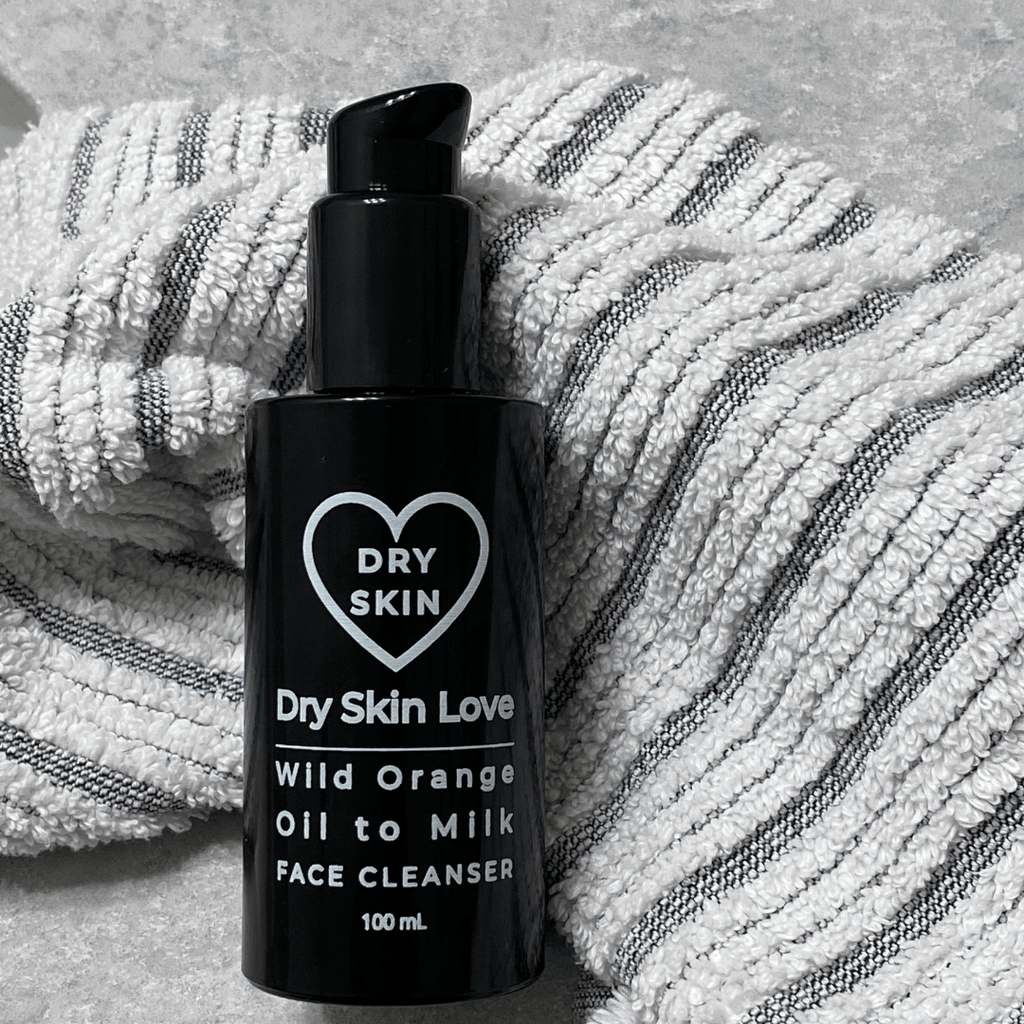Oil cleansing is a technique used to clean your face using oils.
Oil cleansing is very effective for gently removing oil-based and waterproof cosmetics, and sunscreens that cannot be easily removed with soap and water.
The best oil cleansers are oil-based cleansers that contains plant seed oils.
Oil cleansers are packed with nutrient-rich oils and leave your skin feeling healthy and nourished. Oil cleansers leave your dry feeling clean, soft, and plump.
This article will discuss:
- Why cleanse your skin?
- What is the oil cleansing method?
- What are the benefits of oil cleansing?
- What is an oil cleanser?
- What is an oil to milk cleanser?
- How to use an oil cleanser?
- Who should use an oil cleanser?
- Summary
- References

Why cleanse your skin?
Cleansing your skin is essential to keeping your skin healthy.
All types of skin, from healthy to diseased, infant to aged, need to be kept clean in order to preserve the skin barrier (Mijaljica et al, 2022).
The main purpose of skin cleansing is to remove impurities from the skin’s surface, including make-up, dirt, grime, and daily skin debris.
Cleansers are designed to remove dirt, sweat, sebum, and oils from the skin (Ananthapadmanabhan, et al, 2004).
To goal is to cleanse skin, without disrupting the skin barrier - i.e. not disrupting the skin pH, nor altering skin microbiota, nor removing the protective lipids and proteins found in the stratum corneum (Mijaljica et al, 2022).
The stratum corneum is the outermost layer of your skin barrier.
Gentle skin cleansing can be challenging, as the skin’s composition and barrier integrity are intricate, inconsistent, and dynamic (Mijaljica et al, 2022).

What is the oil cleansing method?
The oil cleansing method is a technique used to clean your face using oils instead of soap or other common cleansers.
It works according to the principle of "like attracts like" as the oils help lift and remove daily sebum and oil build up, dirt and skin debris.
Oil cleansing is very effective for gently removing oil-based and waterproof cosmetics, and sunscreens that cannot be easily removed with soap and water.
The oil cleansing method is effective for cleansing skin and is safe to use daily.
The oil cleansing method will not clog pores if the correct oil cleanser is used.

What are the benefits of oil cleansing?
Oil cleansing is very gentle on your skin and protects your skin barrier.
There are many beneficial fats and lipids that are naturally found in your skin barrier and play a critical role in keeping your skin healthy.
Beneficial fats and lipids help to lubricate and coat your skin cells and nourish your skin.
Oil cleansing effectively cleanses your skin and removes all types of makeup and sunscreens effortlessly.
Oil cleansing doesn’t dry out your skin: You’re replenishing oils as you cleanse, instead of just stripping it away with soap.
Oil cleansers are packed with plant oils that are nutrient-rich and lubricating: They leave your skin so soft, and you may find, you don’t need a moisturizer afterwards.
What is an oil cleanser?
Oil cleansers are soap-less cleansers that are composed of oils.
Most oil cleansers do not contain water.
An oil cleanser is made from plant-based oils, and may also include mineral oils, animal-based oils, and/or esters.
A simple oil cleanser may be composed of a single plant oil, whereas a more complex oil cleanser may contain several plant oils, as well as extracts, actives and aroma compounds.
Some plant oils in oil cleansers could include:
For dry skin:
- Coconut Oil
- Jojoba Seed Oil
- Apple Seed Oil
For all skin types:
- Sunflower Seed Oil
- Hemp Seed Oil
- Castor Seed Oil
Different plant oils have different properties, including textures, aromas, colors, skin feel, nutrient profiles and benefits.
What is an oil to milk cleanser?
An oil to milk cleanser is similar to an oil cleanser but is also contains an emulsifier to help it rinse away clean with water.
Oil to milk cleansers can emulsify dirt, oil and microorganisms on the skin surface so that they can be easily removed with water.
Oil to milk cleansers rinse away clean, and do not leave a greasy feeling on your skin.
Oil to milk cleansers leave your skin feeling clean, soft, and plump.

How to use an oil cleanser?
An oil cleanser can be used as a face cleanser, a make-up remover and as a mask.
For best results, always apply an oil cleanser to your dry skin (not even a little damp...)
As a cleanser and make-up remover: With dry hands, apply a generous amount of oil cleanser, and massage into dry face and neck. Gently remove cleanser with a warm moistened cloth. Use daily as required.
Can be used as a stand-alone cleanser, or as the first step oil cleanser in two step cleansing.
As a mask: With dry hands, apply a generous amount of oil cleanser, and massage into dry face and neck. Let sit for 20 min and up to 1 hour. Gently remove cleanser with a warm moistened cloth.
More info: 7 Ways to Use an Oil to Milk Face Cleanser for Dry Skin
Who should use an oil cleanser?
Oil cleansing is great for all skin types, but especially recommended for dry skin.
Dry skin appears dry, rough, and may scale and flake. It may also show premature signs of aging, like fine line, surface wrinkles and loss of elasticity.
Dry skin is skin that is lacking water, humectants and fats. Humectants absorb and hold water, while fats coat the skin and seal in moisture. When there is not enough water, humectants or fats, skin barrier disruption can occur, further worsening symptoms of dry skin.
Oil cleansers are the best face cleansers for dry aging skin.

Summary
What is oil cleansing?
Oil cleansing is a technique used to clean your face using oils.
An oil cleanser is an oil-based cleanser that contains plant seed oils.
Oil to milk face cleansers also contain emulsifiers, so they can rinse clean upon contact with water.
Oil cleansers are gentle cleansers that can effectively remove daily dirt, skin debris, makeup and sunscreen.
Oil cleansers are packed with nutrient-rich oils and leave your skin feeling healthy and nourished.
Oil cleansers leave you skin feeling clean, soft, and plump.
References:
Ananthapadmanabhan KP, Moore DJ, Subramanyan K, Misra M, Meyer F. Cleansing without compromise: the impact of cleansers on the skin barrier and the technology of mild cleansing. Dermatol Ther. 2004;17 Suppl 1:16-25.
Chen W, He M, Xie L, Li L. The optimal cleansing method for the removal of sunscreen:Water, cleanser or cleansing oil? J Cosmet Dermatol. 2020 Jan;19(1):180-184.
Kim, J. E., & Lee, J. N. (2019). The Effects of Cleansing oil on Skin by preferred Vegetable Base oil. Journal of the Korea Academia-Industrial cooperation Society, 20(4), 264-274.
Marina AM, Man YB., Nazimah SA. & Amin I. (2009). Antioxidant capacity and phenolic acids of virgin coconut oil. International Journal of Food Science and Nutrition, 60, 114-123.
Mijaljica D, Spada F, Harrison IP. Skin Cleansing without or with Compromise: Soaps and Syndets. Molecules. 2022 Mar 21;27(6):2010.
Yu, J., Jang, A., & Chang, B. Comparative Analysis of skin Condition after Using Cleansing Oil and Cleansing Water for removing Facial Makeup. Medico-Legal Update. 2019.
Author Information

Dr. Natasha Ryz is a scientist, skin care expert and an entrepreneur. She is the founder of Dry Skin Love Skincare, and she creates skincare products for beauty, dry skin and pain relief.
Dr. Ryz has a PhD in Experimental Medicine from the University of British Columbia in Vancouver, and she is a Vanier scholar. She also holds a Master of Science degree and a Bachelor of Science degree from the University of Manitoba in Winnipeg.
Natasha is the former Chief Science Officer of Zenabis Global, and she oversaw extraction, analytics, and product development. Her team brought 20 products to market including oils, sprays, vapes and softgels.
Why I Started A Skincare Company



